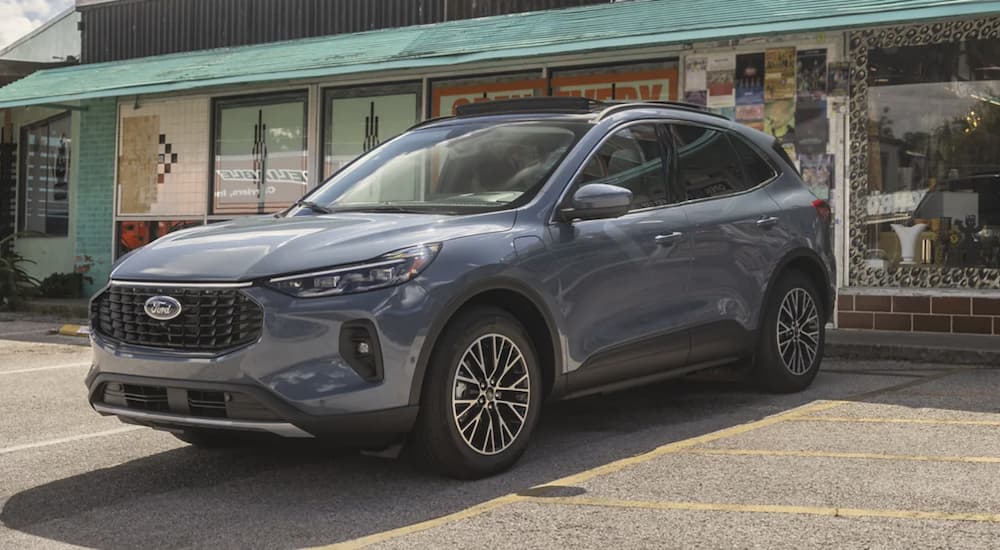There’s no shortage of excitement surrounding the upcoming model year. In an industry that closely follows the rise and fall of various trends and continually changes to adhere to the ever-growing demand of consumer needs, a new model year is a time of great anticipation. Among the many vehicles that are set to make a sizable impact in the upcoming months, the 2023 Ford Escape is one of many SUVs that continue to produce large sales figures as the class has cornered the market for family-oriented buyers and off-roaders alike.
If one were to look at the evolution of the SUV that’s taken place over the past few decades, you might take notice that what was once large and cumbersome is now scaled-down and compact. Any evolutionary chart usually necessitates the existence of a “missing link” or a bridge between two worlds. Believe it or not, the Ford Escape helped change the course of history and realize the potential of smaller-sized SUVs. Today, we go back to the dawn of the new millennium and see this change in action.
A New Day Begins
As the new millennium began, the Ford SUV fleet consisted of three primary vehicles: the Explorer, Expedition, and Excursion. These were part and parcel of the general thought process at the time, bigger powertrains and larger sizes. It was amidst this landscape that the Ford Escape would make its debut for the 2001 model year. The Escape was slightly smaller than some of its domestic SUV brethren yet not as diminutive in stature as some of the offerings from Toyota and Honda. What set the Escape apart was that while out retained the stylings of the current SUV fleet, it existed on a much smaller scale than its larger siblings.
2001: An Escape Odyssey
One of the most significant aspects of the Ford Escape was that it was equipped with a series of powertrains in its first generation that contradicted what the norm had been. In an age where the V8 engine had been the norm, the powertrain for the Escape never got larger than a 3.0L V6, and its first two offerings consisted of two four-cylinder engines, 2.0L and 2.3L. This practice of four and six-cylinder engines, which is now considered the norm for many SUVs on the market, can be traced back to the formative years of the Ford Escape. Aside from its engine, the Escape also offered drivers the option to take advantage of a five-speed manual transmission. While manual shifting has gradually been phased out of SUVs, Ford offering it as part of the drivetrain in the early days illustrated the sportiness of the SUV, which has been a major selling point across the industry in recent years.
Going Electric
The concept of a hybrid SUV has certainly become normalized in the past decade. So much so that even pickup trucks now come in fully electric versions, allowing consumers to circumnavigate the necessity for fill-ups altogether. With its scaled-down size and ability to operate with smaller and more fuel-efficient engines, it was only natural that the Ford Escape would utilize the technology to go electric. Hybrid options in the early 2000s were limited, to say the least, with the technology mostly being utilized on smaller-sized sedans and not larger vehicles. The Escape would become the first hybrid SUV made by a domestic manufacturer in 2004, to be released for the 2005 model year.
The 2005 Ford Escape Hybrid utilized a combination of gas and electricity, with a 2.3L four-cylinder engine and 330 V electric motor to generate 155 horsepower. This powertrain, when combined with a CVT (continuously variable transmission), resulted in an SUV that had unprecedented fuel economy. The fuel economy ratings of 30 MPG in the city, 28 MPG on the highway, and 29 MPG combined were relatively unprecedented for an SUV in this time period. It’s easy to take the electric-hybrid SUV for granted in the modern era, and it’s important to recognize the accomplishments of Ford in this area.
2008: A Revolution of Innovation
The second generation of the Ford Escape was launched for the 2008 model year. While there might have been buzz about the restyled exterior, which combined the look of the Explorer and Edge, major changes had been implemented to keep up with the growing changes in the SUV marketplace. Driver assistance software, known as SYNC, would now be standard from the 2009 model year going forward, and the hybrid edition of the Ford Escape was now improved for the benefit of consumers. 2009 would see an improved engine in the form of a 2.5L four-cylinder and improved fuel economy with 34 MPG in the city, 31 MPG on the highway, and 32 MPG combined.
Production of the third generation, which would coincide with the 2013 model year, would result in a streamlined design that saw the Escape complete its transition into the subcompact class of SUVs that are well-known and popular. The manual transmission was discontinued in favor of a six-speed automatic. The V6 engine and hybrid engine were also discontinued, and in their places were two turbocharged four-cylinder engines that still produced quality performance without breaking the bank at the pump. The changes implemented on the Escape over these crucial years would help change the entire thought process of the SUV, and these results are still noticeable today across the scope of the entire industry.
Numbers certainly don’t lie, and since its debut, sales for the Ford Escape have continually eclipsed over 100,000 units sold each year, with some years even yielding sales figures of over 200,000. The fact that it continues to sell as well as it does is a testament to the ingenuity of Ford as a brand.
Changing the Marketplace for the Better
It seems more than appropriate that Ford would be the manufacturer to streamline the progress at which the SUV has evolved over the past few decades. Its implementation of the only car several years ago saw the golden age of the muscle car arrive, and when one takes a look at what the SUV would eventually become, it’s impossible not to credit the Ford Escape with leading the way. Just as the Explorer would sow the seeds of popularity that several models have now cultivated, the Escape showed the world that the SUV didn’t require monstrous powertrains to be capable and that a vehicle produced in a smaller size could bring consumer advantages on a larger scale. In the years that have passed since the Escape first rolled off of the assembly line, we’ve seen the four-cylinder engine become the norm, and the SUV steal the spotlight from both the minivan and station wagon as the ideal family vehicle.
With more and more manufacturers focussing their efforts on smaller-sized SUVs and hybrid powertrains taking control across the industry, it’s important that the Ford Escape receive its recognition as a vehicle that helped shift the paradigm and change the way the game is played. This model showed people that there were more desirable options out there for owning an SUV than just big, bulky, and inefficient.




